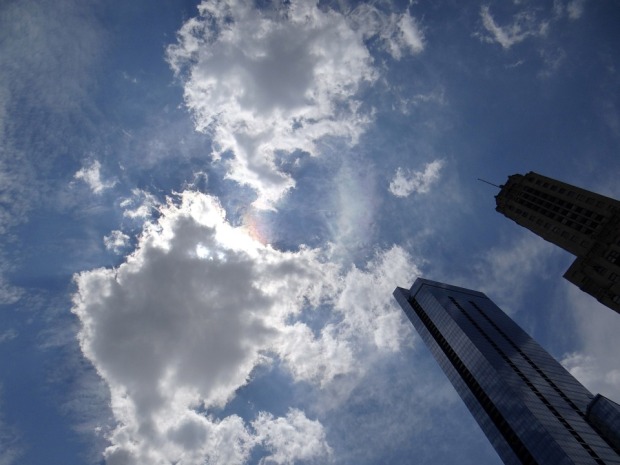
Have you ever thought of the differences between the terms “partly cloudy” versus “mostly sunny”? Does one sound more optimistic than the other? Well in this second installment of a two-part series, I will offer a perspective on the rhetoric used in general weather forecasts. The first part of this two-part blog series centered on the rhetoric used in severe weather watches and/or warnings. While it is certainly important to understand what the various terms mean when dangerous weather warnings are issued, having an understanding of basic weather terminology can facilitate the understanding of basic weather messages, including the local forecast.
Sky Condition
When you hear the forecast for your area, you will hear if it will be cloudy, sunny, etc. This describes the predominant sky condition based on the percentage of opaque (not transparent) cloud cover. Although there is some subjectively in what someone perceives as the character of the sky, the National Weather Service has some general guidelines in describing sky condition.
Cloudy / Overcast 88-100%
Mostly Cloudy / Considerable Cloudiness 70-87%
Partly Sunny / Mostly Cloudy 51-69%
Mostly Sunny / Partly Cloudy 26-50%
Sunny / Mostly Clear 6-25%
Sunny / Clear 0-5%
So as you can see the terms “partly sunny” and “mostly cloudy” are interchangeable. As are “mostly sunny” and “partly cloudy”. The choice of words is really dependent on the mood of the weather forecaster, sort of as a seeing the glass as half full thing. For more enlightenment on this issue, click here for a brief discussion on this topic from another meteorologist.
Precipitation Chances
According to the National Weather Service, the Probability of Precipitation (POP) is defined as the likelihood of occurrence (expressed as a percent) of a measurable amount of liquid precipitation (or the water equivalent of frozen precipitation) during a specified period of time at any given point in the forecast area. Measurable precipitation is equal to or greater than 0.01”. Terms such as occasional, intermittent, or periods of are used to describe a precipitation event that has a high probability of occurrence (80% +) but is expected to be of an “on and off” nature.
When precipitation is in the forecast, often you will hear a percentage assigned to it. These percentages represent the probability assigned for the type of precipitation specified. The rhetoric used is slightly different when stratiform (non-convective) rain and/or snow is expected versus convective precipitation events. Below are the percentages typically assigned to a precipitation forecast and the rhetoric used with these percentages.
20 percent = slight chance of rain or snow or isolated thunderstorms
30, 40, and 50 percent = chance of rain or snow or scattered thunderstorms
60 and 70 percent = likely rain or snow or numerous thunderstorms
Temperature
Believe it or not, there is a lot of ambiguity in a forecast temperature. One meteorologist may think a temperature in the lower 40s can include temperatures up to 45 degrees, and another meteorologist may think the lower 40s only includes 41-43 degrees. Then there is the issue when the terminology “around” is used. How about the adjectives used to describe the character of the temperature? Again this is highly subjective, and is also location dependent. If you are from Chicago and a high temperature of 42 degrees in January sounds like a nice, mild winter day. However if you are from a warmer climate, New Orleans for example, a high of 42 sounds pretty chilly. What it boils down to is the perception of “hot”, “cold”, “chilly”, and etc. are location dependent. Being from the Chicago area, I associate temperatures 90 degrees and above as “hot” (I also think the mid to upper 80s are hot but 90, in my opinion, is the lower threshold for the “hot” adjective to be used. Not so in Texas. When I lived in Amarillo, my colleagues thought I was nuts when I expressed that I considered 90 degrees as hot. They did have a point as I did live there during the hottest summer I ever experienced; 30 days of high temperatures of at least 100 degrees! Now that is downright, furnace-like hot!
Winds
The last weather terminology I would like to provide some insight into are winds. Although a bit more straightforward than sky cover, precipitation chances, and temperatures, National Weather Service like to append adjectives to wind forecasts. Below are the commonly used adjectives for winds.
0-5 mph Calm / Light / Light & variable
5-15 mph / 10-20 mph (None used)
15-25 mph Breezy (mild weather) Brisk or Blustery (cold weather)
20-30 mph / 25-35 mph Windy
30-40 mph Very windy
40 mph or greater Strong, dangerous, high, damaging (High Wind Warning criteria)
Concluding remarks
Hopefully this second installment of this series of blog posts have provided you with enough information so you can make better sense of the daily weather forecast. In addition, you may now have a better understanding of why certain adjectives are used in forecasts. So if someone asks you if you know the difference between “partly sunny” and “mostly cloudy”, you will be able to explain to them what these weather terms mean.